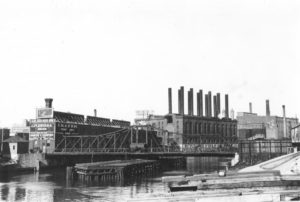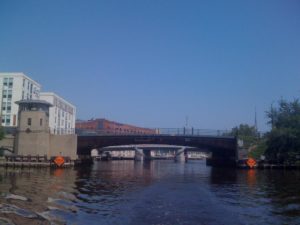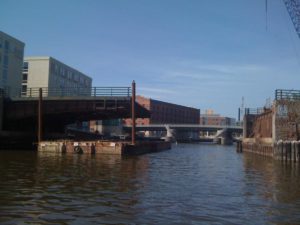[wr_row width=”boxed” background=”none” solid_color_value=”#FFFFFF” solid_color_color=”#ffffff” gradient_color=”0% #FFFFFF,100% #000000″ gradient_direction=”vertical” repeat=”full” img_repeat=”full” autoplay=”yes” position=”center center” paralax=”no” border_width_value_=”0″ border_style=”solid” border_color=”#000″ div_padding_top=”10″ div_padding_bottom=”10″ div_padding_right=”10″ div_padding_left=”10″ ][wr_column span=”span12″ ][wr_text text_margin_top=”0″ text_margin_bottom=”0″ enable_dropcap=”no” appearing_animation=”0″ disabled_el=”no” ][back to Milwaukee’s Bridges Page]
REPLACING THE JUNEAU AVENUE BRIDGE
The Juneau Avenue Bridge was originally known as the Chestnut Street Bridge and was built in 1840. It was the infamous bridge partially destroyed at the beginning of the Milwaukee Bridge War. The Juneau Avenue Bridge, constructed in 1953 and replaced in 2012, was the fifth bridge on the site and was a bascule bridge that spanned the Milwaukee River between Water Street and Old World Third Street.

Milwaukee received $14 million in TIGER (Transportation Investment Generating Economic Recovery) stimulus funds to replace the Juneau Avenue Bascule Bridge with a lift bridge, a less costly option in terms of future maintenance and operation. The replacement project also involved total replacement of the bridge operator’s house with a new structure.
[Photo above courtesy of Milwaukee County Historical Society]
SIGNIFICANCE OF THE JUNEAU AVENUE BRIDGE
Tentative plans for the current Juneau Avenue Bridge were developed in 1951 by the City of Milwaukee Bureau of Bridges and Public Buildings and featured the “Milwaukee Type” simple trunnion bascule design.
Bridge construction was delayed when concerns were raised that the planned 80-foot bridge width was too narrow. Once the 90-foot bridge width was established, construction was delayed further by a shortage of steel caused by the Korean War. City officials personally went to Washington, D.C. in order to obtain the permissions necessary to purchase the steel. Finally, two years and four months after the decision to build the bridge was made, construction began. It officially opened to traffic on February 1, 1954.

The Juneau Avenue Bridge featured the first single control tower arrangement in Milwaukee, an innovation designed to reduce costs by eliminating one of the bridge operators. Up to this point, bascule bridges in Milwaukee had featured two towers, one for each leaf of the bridge.
However, beginning with the Juneau Avenue Bridge, one tower controlled both sides via the use of a submerged cable. Existing Milwaukee bascule bridges were soon converted to a one-man operation, the first being the 1940 Cherry Street Bridge in 1953. When constructed, the Juneau Avenue Bridge also featured a traffic control system designed to accommodate the variety of situations that could occur with the intersection of boat, vehicular, and rail traffic (as a major rail line crossed Juneau Avenue adjacent to the bridge).

The Juneau Avenue Bridge illustrated the distinctive design features common to the “Milwaukee Type” bascule bridge, including counterweights, leaf superstructures, and operating machinery located below the deck and away from the vehicular traffic area. This design was developed and perfected in Milwaukee.
At the time of its replacement in 2012, the Juneau Avenue Bridge was one of only seven bascule bridges that remained in downtown Milwaukee. As a later example, it represents the continuity of the design from 1924 through the 1950s.
*Return to the Milwaukee River Bridges Main Page[/wr_text][/wr_column][/wr_row]
